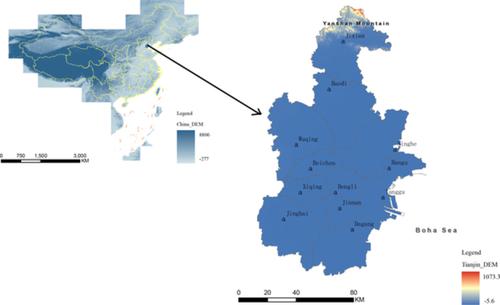当前位置:
X-MOL 学术
›
Meteorol. Appl.
›
论文详情
Our official English website, www.x-mol.net, welcomes your feedback! (Note: you will need to create a separate account there.)
Evaluation and grading of climatic conditions on nutritional quality of rice: A case study of Xiaozhan rice in Tianjin
Meteorological Applications ( IF 2.7 ) Pub Date : 2021-08-16 , DOI: 10.1002/met.2021 Sining Chen 1 , Jun Guo 1 , Yanxia Zhao 2 , Xingyang Li 3 , Fang Liu 1 , Yuehao Chen 1
Meteorological Applications ( IF 2.7 ) Pub Date : 2021-08-16 , DOI: 10.1002/met.2021 Sining Chen 1 , Jun Guo 1 , Yanxia Zhao 2 , Xingyang Li 3 , Fang Liu 1 , Yuehao Chen 1
Affiliation

|
Based on the daily meteorological monitoring data of Xiaozhan rice in Tianjin planting area from 2010 to 2020 and the observation data of nutritional quality of Xiaozhan rice in Tianjin from 2014 to 2020, comprehensive characterization parameter M of nutritional quality of Xiaozhan rice in Tianjin and the evaluation model of meteorological conditions' influence on the nutritional quality of rice was established by principal component analysis, ordered sample optimal clustering method and stepwise regression method. The climatic evaluation grades of nutritional quality of Xiaozhan rice in Tianjin were divided into four grades. The comprehensive characterization parameter (M) of nutritional quality of Xiaozhan rice can be determined using five quality factors (protein, amylose, gel consistency, amino acid and chalkiness) into three weighted sums, and the coefficients are is the proportion of the eigenvalues corresponding to the three principal components to the total variance of the original variables. The thresholds of M corresponding to the four grades of ‘general’, ‘good’, ‘excellent’, ‘extra-superior’, in the climatic evaluation of nutritional quality of Xiaozhan rice in Tianjin were M < 0.3, 0.3 ≤ M < 0.45, 0.45 ≤ M < 0.7, 0.7 ≤ M, respectively. The results showed that M was related to 14 meteorological factors such as average temperature, minimum temperature, maximum temperature, precipitation, sunshine duration and daily range in different months of rice growth period. Among them, the temperature condition in September was the key factor affecting the nutritional quality of Xiaozhan rice, including amylose, gel consistency, protein, chalkiness and the comprehensive characterization parameter (M). September is the period from grain filling (the grain filling stage of rice refers to the period from the end of flowering to the beginning of glume closure to grain maturity) to mature harvest of Xiaozhan rice in Tianjin. That is to say, the temperature in this period has a very significant effect on the final nutritional quality of Xiaozhan rice. The correlation between the 14 factors and M is high, and all 29 pass the Pearson correlation significance test of p < 0.01. The absolute value of lowest correlation coefficient is sunshine hours in May, |R| = 0.839; and the absolute value of highest correlation coefficient was the highest temperature in June, R = 0.982. Among the 14 factors, 9 factors are related to temperature (including the day difference in June), and all of them positively correlated with climate evaluation index M of nutritional quality, 3 factors are related to sunshine hours, and 2 factors are related to precipitation, indicating that the temperature condition in the whole growth period of Xiaozhan rice is the most important climate factor to determine its nutrition quality formation. The root mean square error of the simulation results of the climate evaluation model for the nutritional quality of Xiaozhan rice is 0.0236, which indicates that the model can be used for the climate impact evaluation of the nutritional quality of Xiaozhan rice in Tianjin, so as to determine the nutritional quality grade of Xiaozhan rice and provide scientific reference for reasonably predicting the market price of Xiaozhan rice.
中文翻译:

气候条件对水稻营养品质的评价与分级——以天津小站水稻为例
基于2010-2020年天津市小站水稻每日气象监测数据和2014-2020年天津市小站水稻营养品质观测数据,对天津市小站水稻营养品质综合表征参数M及评价采用主成分分析法、有序样本最优聚类法和逐步回归法建立气象条件对水稻营养品质影响的模型。天津小站水稻营养品质的气候评价等级分为四个等级。综合表征参数(M) 可将五个品质因子(蛋白质、直链淀粉、凝胶稠度、氨基酸和垩白度)三个加权和确定,系数为三个主成分对应的特征值与原始变量的总方差。的阈值中号对应于四个等级的“一般”,“良好”,“极好”,“超一流”,在天津小站稻的营养品质的气候评价是中号 <0.3,0.3≤ 中号 <0.45 , 0.45 ≤ M < 0.7, 0.7 ≤ M分别。结果表明,M与水稻生育期不同月份的平均气温、最低气温、最高气温、降水量、日照时长、日差等14个气象因子有关。其中,9月份的温度条件是影响小站米营养品质的关键因素,包括直链淀粉、凝胶稠度、蛋白质、垩白度和综合表征参数(M)。9月是天津小站水稻从灌浆期(水稻灌浆期是指从花期结束到颖苞闭合到籽粒成熟的时期)到成熟收获的时期。也就是说,这个时期的温度对肖战米的最终营养品质有着非常显着的影响。14 个因素与 M 之间的相关性很高,并且所有 29 个因素都通过了p < 0.01的 Pearson 相关显着性检验。相关系数最低的绝对值是5月份的日照时数,| R | = 0.839; 相关系数最高的绝对值为6月的最高气温,R = 0.982。14个因子中,有9个因子与温度有关(包括6月份的日差),均与气候评价指数M呈正相关在营养品质方面,3个因素与日照时数有关,2个因素与降水量有关,说明小站水稻整个生育期的温度条件是决定其营养品质形成的最重要的气候因素。小站水稻营养品质气候评价模型模拟结果的均方根误差为0.0236,表明该模型可用于天津小站水稻营养品质的气候影响评价。确定小站大米的营养品质等级,为合理预测小站大米的市场价格提供科学参考。
更新日期:2021-08-17
中文翻译:

气候条件对水稻营养品质的评价与分级——以天津小站水稻为例
基于2010-2020年天津市小站水稻每日气象监测数据和2014-2020年天津市小站水稻营养品质观测数据,对天津市小站水稻营养品质综合表征参数M及评价采用主成分分析法、有序样本最优聚类法和逐步回归法建立气象条件对水稻营养品质影响的模型。天津小站水稻营养品质的气候评价等级分为四个等级。综合表征参数(M) 可将五个品质因子(蛋白质、直链淀粉、凝胶稠度、氨基酸和垩白度)三个加权和确定,系数为三个主成分对应的特征值与原始变量的总方差。的阈值中号对应于四个等级的“一般”,“良好”,“极好”,“超一流”,在天津小站稻的营养品质的气候评价是中号 <0.3,0.3≤ 中号 <0.45 , 0.45 ≤ M < 0.7, 0.7 ≤ M分别。结果表明,M与水稻生育期不同月份的平均气温、最低气温、最高气温、降水量、日照时长、日差等14个气象因子有关。其中,9月份的温度条件是影响小站米营养品质的关键因素,包括直链淀粉、凝胶稠度、蛋白质、垩白度和综合表征参数(M)。9月是天津小站水稻从灌浆期(水稻灌浆期是指从花期结束到颖苞闭合到籽粒成熟的时期)到成熟收获的时期。也就是说,这个时期的温度对肖战米的最终营养品质有着非常显着的影响。14 个因素与 M 之间的相关性很高,并且所有 29 个因素都通过了p < 0.01的 Pearson 相关显着性检验。相关系数最低的绝对值是5月份的日照时数,| R | = 0.839; 相关系数最高的绝对值为6月的最高气温,R = 0.982。14个因子中,有9个因子与温度有关(包括6月份的日差),均与气候评价指数M呈正相关在营养品质方面,3个因素与日照时数有关,2个因素与降水量有关,说明小站水稻整个生育期的温度条件是决定其营养品质形成的最重要的气候因素。小站水稻营养品质气候评价模型模拟结果的均方根误差为0.0236,表明该模型可用于天津小站水稻营养品质的气候影响评价。确定小站大米的营养品质等级,为合理预测小站大米的市场价格提供科学参考。


























 京公网安备 11010802027423号
京公网安备 11010802027423号